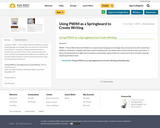
Students analyze an assortment of popular inventions to determine whom they are intended to benefit, who has access to them, who might be harmed by them, and who is profiting by them. Then they re-imagine the devices in a way that they believe would do more good for humanity. During the first 90-minute class period, they evaluate and discuss designs in small groups and as a class, examining their decision-making criteria. Collectively, they decide upon a definition of "ethical" that they use going forward. During the second period, students apply their new point-of-view to redesign popular inventions (on paper) and persuasively present them to the class, explaining how they meet the class standards for ethical designs. Two PowerPoint® presentations, a worksheet and grading rubric are provided.
- Subject:
- Science
- Material Type:
- Activity/Lab
- Provider:
- TeachEngineering
- Provider Set:
- TeachEngineering
- Author:
- Alex Mejia
- Amy A. Wilson
- Christina Sias
- Date Added:
- 05/07/2018
